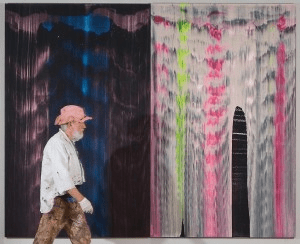
The small house in Venice, Calif., where Ed Moses lives is filled with his new paintings, spare diagonal grids of red and black. The extra bedroom has been turned into storage while out the back, lying on saw horses, are more paintings in progress. Moses, with a full beard and shaggy hair, shambles past that busy scene, with assistants bustling to and fro, and opens the door to a chapel-like space in his large studio building. With a devilish grin, he relishes the surprise that he is about to spring: Vertical panels of fun-house mirrors, eight feet tall and five feet wide, are dotted with teardrops of sprayed color. They are hung alongside his vertical monochrome paintings in black or yellow and another series of monochromes with cracked surfaces in blue and white. The colored monochrome paintings are wobbling and jarring in the mirrors, which also reflect the artist himself and the viewer. Like the renowned chapel in Houston for which Mark Rothko created a suite of transcendental paintings, this presentation by Moses is potent, intentional, and interrogatory. What exactly are we seeing?